Peculiarities of brain electric activity in young males and females of different creativity levels
Abstract
This article shows that the peculiarities of divergent and convergent thinking in young males and females of various creativity levels are stipulated by a definite EEG frequency-and-spatial arrangement. Young males and females of mixed and left lateral arrangement profiles demonstrate an expressed activity of occipital, central, and temporal areas of both cerebral hemispheres. In young males and females of right LAP (lateral arrangement profile), connections are clearly localized in case of solution of both convergent and divergent tasks. Solution of divergent and convergent tasks may condition certain frequency-and-spatial arrangement of EEG in young males and females with different levels of academic progress and a different lateral arrangement profile (LAP).
Received: 01.06.2013
Accepted: 18.08.2013
Themes: “Science in Dialogue” — 10th Sino-German Workshop Selected Papers; Psychophysiology
Pages: 31-40
DOI: 10.11621/pir.2013.0303
Keywords: creativity, lateral arrangement profile (LAP), intrahemispheric and interhemispheric coherent connections, convergent tasks, divergent tasks, academic progress, gender.
1. Introduction
The problem of brain mechanisms in creative thinking is among the most prominent in modern psychophysiology (Bekhtereva, 2006; Volf, Razumnikova, 2009, 2010; Fink, 2010; Mihov, Denzlerb, Försterb, 2010; Zenasni, Lubarta, 2011, etc.).
There are currently quite a number of investigations devoted to the peculiarities of interhemispheric action, and the specific roles played by each hemisphere in creative thinking and individual diversities (Razumnikolva, 2001; Hoppe, 1988; Zenasni, Lubartа, 2011, etc.). Some other investigations show the role of the prefrontal areas in both hemispheres, the frontal and temporal areas in the right hemisphere, the occipital zone in the left hemisphere, the parietal and central areas in both hemispheres, and the frontal temporal areas in both hemispheres in verbal and non-verbal creative thinking (Bekhtereva, 2006; Volf, Razumnikova, Bryzgalov, 2010, etc.).
The existing data on the roles of the right and left brain hemispheres in creative thinking are rather contradictory: on the one hand, the right hemisphere is involved in creation in divergent thinking (Razumnikolva 2001, 2009; Shamay-Tsoorya, Adlera, Aharon-Peretzb, Perrya, Mayselessa, 2011, etc.); on the other hand, the activation of the right cortex is also possible in convergent thinking (Hoppe, 1988).There is also data fr om many researchers indicating a closer interhemispheric integration and a less expressed brain asymmetry in creative individuals.
The topicality of studying the professional behavior of the personality, specifically its creative potential, development and formation mechanisms, has greatly increased under the conditions of the economy of Russia (Barysheva, 2006; Guselnikova, 2008; Petrova, 2009, etc.).
However, there are practically no investigations concerning specific brain mechanisms (EEG correlates) in people of different creativity levels, and concerning their connection with individual typological peculiarities.
The objective of this investigation is to study brain electric activity peculiarities in young males and females of different creativity levels in solving cognitive tasks.
2. Subject and research methods
2.1 Subject of research
The subject under examination is the frequency-and-spatial EEG characteristics in young males and females of different creativity levels and lateral arrangement profiles (LAP) in the solution of cognitive tasks.
The test group included 2nd to 5th year students of the Southern Federal University majoring in humanities: 190 people aged between 18 and 23, among them 93 males and 97 females. In accordance with the above objective, all the test subjects were subdivided into smaller groups depending on creativity level, academic performance level, lateral arrangement profile (LAP), and gender. The grouping was done after a number of psychological and psychophysiological methods were applied to the test subjects.
2.2. Research methods
Research methods: literature analysis, psychological tests, talks, method of electroencephalography (EEG), expert evaluation method.
Psychodiagnostic methods. Guilford methods in the Tunik modification (to diagnose verbal creativity) and Torrance picture completion test (to diagnose non-verbal creativity); T.A. Bragina and N.N. Dobrokhotova’s functional interhemispheric asymmetry profile determination methods.
To diagnose non-verbal creativity, a brief version of the Torrance test was applied, modified at the ability diagnostics lab of the Psychology Institute of the Academy of Education of Russia by A.N. Voronin. The short version of the Torrance test is a set of 6 pictures with a certain number of elements which are to be used by the test subject to complete the picture, so that it can finally become a sense-bearing image.
The test enables the following creativity factors to be determined:
- originality (Or), i.e. non-likeness of the given picture to the pictures created by other test subjects, i.e. statistical infrequency of the reply;
- uniqueness (Un), i.e. singularity of the given picture type in the whole series.
As the results obtained after the data from all the test subjects had been treated, these results could be resolved into the following three groups.
Group 1: persons demonstrating a low level of non-verbal creativity; results lower than the originality level Or ≤ 0.48, uniqueness level Un = 0.5;
Group 2: persons demonstrating a middle level of non-verbal creativity; results within the following limits: originality level 0.48 < Or ≤ 0.76, uniqueness level being 0 < Un ≤ 2;
Group 3: persons demonstrating a high level of non-verbal creativity; results exceeding the originality level Оr > 0.76, uniqueness level being Un > 2.
To diagnose verbal creativity, the investigation applied the J. Guilford method in the Tunik modification.
After the results obtained after the data from all the test subjects had been trea- ted, these results could be resolved into the following three groups:
Group 1: persons demonstrating a low level of verbal creativity; results lower than the originality level Or ≤ 0.81, uniqueness level 0 < Un ≤ 2;
Group 2: persons demonstrating a middle level of verbal creativity; results within the following limits: originality level 0.82 < Or ≤ 0.93, uniqueness level being 2 < Un ≤ 5;
Group 3: persons demonstrating a high level of verbal creativity; results ex- ceeding the originality level Оr > 0.94, uniqueness level being Un > 5.
T.A. Bragina and n.n. Dobrokhotova’s functional interhemispheric asym- metry profile determination methods. The said methods comprise a number of questions and assess motor asymmetry (hand, foot) and sensor asymmetry (ear, eye) with a further determination of the profile: right, left, mixed, ambidextrous.
Psychophysiological methods. The investigation applied the EEG (electroencephalography) method. EEG recordings were carried out according to international standards 10–20%, in line with the standard procedure of registering EEG background, eye-opening and eye-closing tests. To register brain electric activity, 21 electrodes were used, a monopolar scheme with ipsilateral ear referents.
2.3. Research procedure
Investigation procedure description. All those who took part in the investigation were subdivided depending on gender, lateral arrangement profile (LAP), and academic progress level. According to LAP, the test subjects were subdivided into those representing left, right, and mixed LAP. They were subdivided according to academic progress level into high progress, moderate progress, and low progress.
Before the EEG examination started, the test subjects were instructed on how to accomplish the verbal and non-verbal tasks. Four types of tasks were used in the investigation:
- verbal convergent (remembering proverbs on a specific topic);
- verbal divergent (inventing one’s own original proverb, or a free creative search task);
- non-verbal convergent (making a drawing on a definite topic out of the offered geometric figures, e.g. a circle, a square, a triangle, of the Tunik test);
- non-verbal divergent (making one’s own drawing out of the offered geometric figures, e.g. a circle, a square, a triangle, of the Tunik test, or a free creative search task).
The above tasks were presented during EEG recording. EEG was also marked at the beginning and end of the presentation; also registered was the signal ‘test subject’s reply’ if this person was ready to give a reply. Test subjects’ replies to verbal tasks were recorded in the study protocols, while replies to non-verbal tasks were drawn by the test subjects themselves after the ‘reply’ signal. Also, while EEG was being recorded, the test subjects were offered background tests (ЕO — eyes open, EC — eyes closed). All the documented data on each test subject were assessed ac- cording to the factors of velocity, flexibility, originality, productivity, and a complex factor of creativity, which permitted the test subjects to be subdivided into high creativity, average creativity, and low creativity.
After this, the EEG data was analyzed. In our investigation we used the mean time spent by the test subject to solve each given task. The said time was the lapse between the end of the task presentation and the ‘reply’ signal given by the test subject.
Each functionally relevant EEG period underwent a spectral and a coherent analy- sis within the frequency ranges: theta1 (4.0–6.0 Hz), theta2 (6.0–8.0 Hz), alpha1 (8.0– 10.5 Hz), alpha2 (10.5–13.0 Hz), beta1 (13.0–24.0 Hz), and beta2 (24.0–35.0 Hz).
Mathematical treatment of the data was carried out with mathematical statisti- cal methods: T-test for independent samples, ANOVA/MANOVA analysis of vari- ance, post hoc analysis. Treatment was done with the help of the STATISTICA 6.0 computer program pack.
3. Results of research
Results. Irrespective of frequency range, it was stated that highly creative young males and females demonstrate the highest (by value) coherent connections in pa- rietal, temporal, and frontal brain areas; for young males and females of right LAP, those were the frontal and temporal areas of the left hemisphere, and for those of left LAP and mixed type in the right or left hemisphere in the solution of divergent tasks in the appropriate brain areas (see Fig. 1).
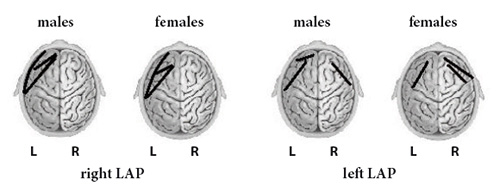
Figure 1. Statistically significant differences in the localization of intra-and inter-hemispheric EEG coherence relations when comparing students with a high level of creativity in solving problems of divergence (p <0.05)
During the solution of convergent tasks, the relevance of coherent connections grew in the frontal, central, and cervical brain zones. At the same time the test subjects of right and mixed LAP show symmetric coherence growth in the central brain zones. The tendency mentioned could also be traced in the young males and females of high creativity, regardless of the level of their progress in studies.
Regarding young males and females of low and average creativity and average and low progress levels, during the solution of convergent tasks, coherence growth was not localized, but diffusely distributed among the central, frontal, and parietal zones of both hemispheres, especially as these groups were solving divergent tasks.
The solution of non-verbal convergent tasks by test subjects of low creativity is characterized by the appearance of highly coherent connections between the middle frontal zone of the left hemisphere and the lateral frontal zone of the right hemisphere, the back cervical and the central left zones; in those of average creati- vity: between the left frontal and back temporal zones of the left hemisphere, the right cervical and the back temporal zones of the left hemisphere; in those of high creativity: between the left frontal and middle frontal zones, central zone of the left hemisphere, and the parietal zone of the right hemisphere (see Fig. 2).
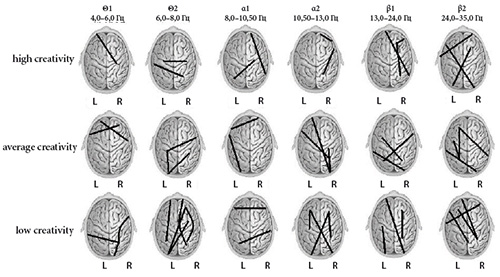
Figure 2. Statistically significant differences in the localization of intra-and inter-hemispheric EEG coherence relations when comparing students with different levels of creativity in solving non-verbal tasks (p <0.05)
During the solution of non-verbal divergent tasks, test subjects of low creativity show characteristic connections between the parietal zones of both hemispheres, the anterior frontal right, the central zone of the right hemisphere, the middle frontal left brain zones. In test subjects of average creativity: between the parietal zone of the right hemisphere and the lateral frontal zone of the left hemisphere. In test subjects of high creativity: in symmetric parietal zones, between the right frontal and right parietal zones (see Fig. 3).
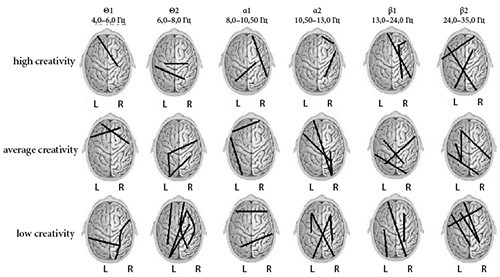
Figure 3. Statistically significant differences in the localizations of intra-and inter-hemispheric EEG coherence relations when comparing students with different levels of creativity in solving non-verbal divergent tasks (p <0.05)
It was found that high values of cortico-cortical connections in the solution of a verbal convergent task, regardless of the frequency range in test subjects of low creativity of the left LAP, can be traced between the left frontal and lateral frontal zones of the right hemisphere.
In test subjects of average creativity it takes place between the back zones of both hemispheres, the left occipital and the right frontal zones.
In test subjects of high creativity, high-value coherent connections are predominantly localized in the frontal zones of both hemispheres, the left frontal and the right lateral frontal brain zones.
Test subjects of right LAP and low creativity levels are characterized by highly coherent connections between the right and left frontal zones; in test subjects of average creativity: between the left frontal and parietal left brain zones; in those of high creativity: between the left occipital and right lateral frontal brain zones.
During the solution of verbal divergent tasks, regardless of the frequency range, test subjects of low creativity and left LAP revealed high cortico-cortical connections between the right frontal and central left brain zones; those of average creativity: between the middle frontal and parietal zones of the left hemisphere; in those of high creativity: connections were predominantly localized between the central zones of both hemispheres, the left frontal and right lateral frontal zones.
In test subjects of low creativity and mixed LAP it was between the parietal and back temporal zones of the right hemisphere, in those of average creativity: between the back temporal right and left frontal, the middle frontal and lateral frontal zones of the right hemisphere; in those of high creativity: between the right frontal and right parietal brain zones.
The test subjects of the right LAP and low creativity level were characterized by highly coherent connections between the back temporal left and middle frontal zones; in those of average creativity: between the lateral frontal left and right frontal zones; in those of high creativity: between the left occipital and lateral frontal left brain zones (see Fig. 4).
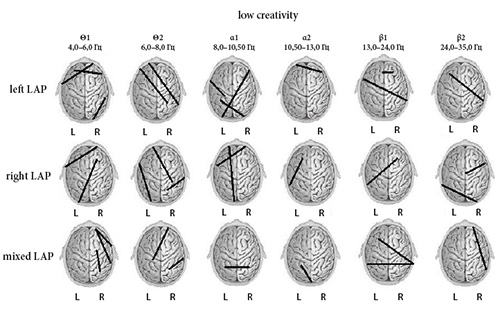
Figure 4. Statistically significant differences in the localization of intra-and inter-hemispheric EEG coherence relations when comparing students with different levels of creativity and LAP in solving a verbal divergent task (p <0.05)
It was revealed that during the solution of verbal tasks, regardless of the frequency range, in test subjects of low progress, the high coherent connections were mainly localized in the anterior frontal zones of both hemispheres, the central zone of the left hemisphere and the anterior frontal zone of the right hemisphere, the central and anterior frontal zones of the right hemisphere.
In test subjects of average progress: in the left anterior frontal zone of the left hemisphere and the frontal temporal zone of the right hemisphere, the posterior temporal right zone and the middle frontal zone of the left hemisphere.
Test subjects of high progress showed interaction between the occipital and frontal zones of the right hemisphere, the cervical zones of the right and left hemispheres. During the solution of a divergent verbal sample, the test subjects of low progress revealed connections between the central and frontal temporal zones of the left hemisphere. Those of high progress showed connections between the right occipital zone and central zone of the right hemisphere, parietal and temporal zones of the left hemisphere.
During the solution of non-verbal convergent tasks, test subjects of low prog- ress showed high coherent connections between the right occipital and central left, right occipital and right hemispheric anterior frontal zones.
Test subjects of high progress showed connections between the anterior frontal left and lateral frontal right brain zones. In the solution of a non-verbal divergent task those of low progress showed connections between the right occipital zone and middle frontal left, anterior temporal zone of the right hemisphere.
Test subjects of average progress showed connections between the left anterior frontal zone of the left hemisphere and the lateral frontal zone of the right hemi- sphere.
Test subjects of high progress showed connections between the back temporal zone of the left hemisphere and the lateral frontal zone of the right hemisphere.
During the solution of a non-verbal convergent sample, regardless of the frequency range, test subjects of low creativity of left LAP revealed high cortico-cortical connections between the central left and back temporal right zones;
those of average creativity revealed connections between the parietal and tem- poral zones of the left hemisphere;
in those of high creativity, connections were mainly localized between the parietal zones of both hemispheres, the right frontal and right lateral frontal brain zones.
In those of low creativity and mixed LAP it was between the back temporal and left central zones, in those of average creativity it was between the right central and frontal temporal zones; in those of high creativity it was between the middle frontal right and back temporal brain zones.
For test persons of right LAP and low levels of creativity, characteristics were highly coherent connections between the back temporal and frontal zones of the left hemisphere; in those of middle creativity it was between the central and middle frontal zones of the left hemisphere; in those of high creativity it was between the lateral frontal and parietal zones of the left hemisphere.
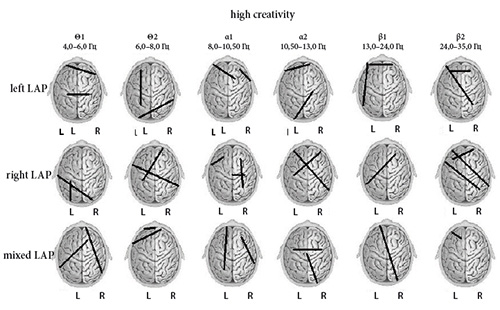
Figure 5. Statistically significant differences in the localization of intra-and inter-hemispheric EEG coherence relations when comparing students with different levels of creativity and LAP in solving a verbal divergent task (p <0.05)
During the solution of a non-verbal divergent sample, regardless of the frequency range, test subjects of low creativity and left LAP showed high coherent connections between the left frontal and temporal right zones; those of average creativity showed connections between the middle frontal zones of both hemispheres; and those of high creativity showed connections essentially localized between the left frontal and right parietal zones.
In those of low creativity and mixed LAP it was between the frontal right and temporal anterior zones of the left hemisphere; in those of average creativity it was between the central and frontal temporal zones of the right hemisphere; in those of high creativity it was between the parietal and lateral frontal zones of the right hemisphere. For test persons of right LAP and low creativity, characteristics were highly coherent connections between the right frontal temporal and lateral frontal zones, the left occipital and frontal temporal left brain zones; in those of average creativity it was between the back temporal left and parietal right zones; in those of high creativity it was between the lateral frontal left and middle frontal right brain zones.
During the solution of verbal convergent tasks, high coherence rates (0.8–1) increased in the frontal, middle frontal, temporal, and parietal brain zones in young females of left LAP. Meanwhile, with young males of left and mixed LAP, the same picture of connection distributions is less localized compared to young males of right LAP, wh ere connections are primarily localized in the left hemisphere. With young females, a picture of coherence intensification in the cervical, parietal, temporal, central, and middle frontal brain zones is typical. The picture of frequency-and-spatial EEG arrangement in young females of right, left and mixed LAP is less clearly localized than in the young males of the appropriate LAP. During the solu- tion of a non-verbal convergent sample, both males and females show an increase of interaction in the back, central, and frontal cerebrum areas. During the solution of divergent tasks, the coherence values for young males and females of high creativity increase in the parietal and anterior frontal brain areas.
Thus the brain electric activity characteristics differ depending on type of task (either divergent or convergent) and creativity level.
The solution of divergent and convergent creative tasks may condition a definite frequency-and-spatial EEG arrangement in young females of different academic progress levels and lateral arrangement profiles.
References
Barysheva, T.A., Zhigalov, Ju.A. (2006). Psikhologo-pedagogicheskie osnovy razvitiya kreativnosti [Psychological and pedagogical foundations for the development of creativity]. SPb.: Piter.
Bekhtereva, N.P. (2006). Magiya tvorchestva i psikhofiziologiya [The magic of creativity and psychophysiology]. St.Petersburg: RAN, Human Brain Institute
Volf, N.V., Razumnikova, O.M. (2004). Polovoy dimorfizm funktsionalnoy organizatsii mozga pri obrabotke rechevoy informatsii [Sexual dimorphism of the functional organization of the brain in the processing of speech information]. Funktcional’naia mezhpolusharnaia asimmetriia. [Functional hemispheric asymmetry] (p. 386). Moscow: Nauchnyj mir.
Volf, N.V., Razumnikova, O.M., Bryzgalov, A.O., Onishchenko, M.A., Lapina, E.Yu. (2010). Neyrofiziologicheskiy analiz mekhanizmov polovogo dimorfizma kognitivnykh strategiy: rol selektivnykh protsessov [Neurophysiological analysis of the mechanisms of sexual dimorphism in cognitive strategies: the role of selective processes]. Biulleten’ CO RAMN [Bulletin SO RAMS], 4(30), 6–13.
Guselnikova, M.S. (2008). Kulturno-analiticheskiy podkhod k fenomenam kreativnosti, neadaptivnosti i genialnosti. [Cultural and analytical approach to the phenomena of creativity, maladaptivity and genius]. Voprosy psikhologii [Issues of psychology], 2, 17–29.
Kozlenko, V.P. (1990) Problemy kreativnosti lichnosti: Psikhologiya tvorchestva: obshchaya, dif- ferentsialnaya, prikladnaya [Problems of creative personality: The psychology of creativity: the total, differential, applied]. Moscow: Nauka, IP RAN.
Nagornova, Zh.V. (2008). Izmeneniya EEG pri obraznoy tvorcheskoy deyatelnosti . Avtoref. diss. kand. biol. nauk. [EEG changes with imaginative creativity] [PhD Thesis]. SPSU, SPb.
Petrova, S.O. (2009). Psikhologicheskiye osobennosti odarennykh podrostkov s raznym sootnosheniem verbalnykh i neverbalnykh sposobnostey. Psikhologicheskaya nauka i obrazovanie [Psychological characteristics of gifted adolescents with different ratios of verbal and non- verbal abilities]. Psihologicheskaia nauka i obrazovanie [Psychological Science and Education], 2, 71–81.
Razumnikova, O.M. (2001). Osobennosti funktsionalnoy lateralizatsii i vzaimodeystviya polushariy kak osnova polovykh razlichiy v divergentnom myshlenii. [Features functional lateralization and hemispheric interaction as the basis of sex differences in divergent thinking]. Aktualniye voprosy funktsionalnoy mezhpolusharnoy asimmetrii [Topical issues of functional hemispheric asymmetry] (p. 148). Moscow: Russian Academy of Medical Science.
Razumnikova, O.M. (2009). Individualniye osobennosti polusharnoy aktivnosti, opredelyayushchie uspeshnost resheniya evristicheskoy zadachi. Asimmetriya [Individual features of hemispheric activity, determining the success of heuristic problem-solving]. Asimmetriia [Asymmetry], 1, 37–50.
Razumnikova, O.M., Volf N.V. (1997). Poloviye razlichiya vremennoy dinamiki mezhpolusharnoy asimmetrii vospriyatiya rechevoy informatsii. [Sex differences in the temporal dynamics of inter-hemispheric asymmetry in the perception of speech information]. Bul. Sibirsk. Otdel. RAMN [Bulletin of the Siberian office of the Russian akademy of medical sciences], 2, 87–90.
Fink, A., Graifa, В., Neubauera, А. С. (2010). Brain correlates underlying creative thinking: EEG alpha activity in professional vs. Novice dancers. NeuroImage, 46(3), 854–862.
Hoppe, K.D. (1988). Hemispheric specialization and creativity. Psychiatr Clin North Am, 3, 303.
Mihov, К.М., Denzlerb, М., Försterb, J. (2010). Hemispheric specialization and creative thinking: A-meta-analytic review of lateralization of creativity. Brain Cognition, 72(3), 442. doi: 10.1016/j.bandc.2009.12.007
Molle, M., Marshall, L., Lutzenberger, W., Pietrowsky, R., Fehm, H.L., Born, J. (1996). Enhanced dynamic complexity in the human EEG during creative thinking. Neurosci Lett, 12, 61. doi: 10.1016/0304-3940(96)12539-8
Petrova, S. (2009). Psychological features of gifted secondary school children with disproportions in verbal and nonverbal abilities. Coherence of conceptual framework, methods, empirical results, conclusions and practical implications. Research seminar on giftedness and talent (pp. 49–61). 2nd edition. Pavia: University of Pavia.
Petsche, H. (1996). Approaches to verbal, visual and musical creativity by EEG coherence analysis. Int J Psychophysiology, 24(2), 145. doi: 10.1016/S0167-8760(96)00050-5
Shamay-Tsoorya, S.G., Adlera, N., Aharon-Peretzb, J., Perrya, D., Mayselessa, N. (2011). The origins of originality: The neural bases of creative thinking and originality. Neuropsychologia, 49(2), 178. doi: 10.1016/j.neuropsychologia.2010.11.020
Zenasni, F., Lubarta, T. (2011). Pleasantness of creative tasks and creative performance. Thinking Skills and Creativity, 6(1), 49–56. doi: 10.1016/j.tsc.2010.10.005
To cite this article: Pavel N.Ermakov, Oxana S. Saakyan (2013). Peculiarities of brain electric activity in young males and females of different creativity levels. Psychology in Russia: State of the Art, 6(3), 31-40
The journal content is licensed with CC BY-NC “Attribution-NonCommercial” Creative Commons license.










